Tagged With ‘violet’
Geoffrey Beene
Grey Flannel
23 February, 2015
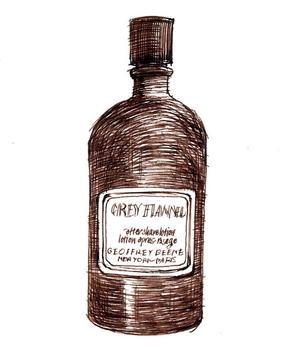 The American fashion designer Geoffrey Beene died of cancer in 2004, but Grey Flannel, the perfume he commissioned from the French fragrance company Roure in the mid-1970s, lives on, and that’s something to be grateful for, as it’s a very appealing scent – even in its current, cheaper incarnation.
The American fashion designer Geoffrey Beene died of cancer in 2004, but Grey Flannel, the perfume he commissioned from the French fragrance company Roure in the mid-1970s, lives on, and that’s something to be grateful for, as it’s a very appealing scent – even in its current, cheaper incarnation.
Created by an otherwise little-known perfumer named André Fromentin, Grey Flannel was launched in 1975 (or 1976, depending on which perfume authority you believe; I’m often surprised how much confusion there seems to be around recent perfume history). Grey flannel was Geoffrey Beene’s signature material, but fortunately that’s not what his first men’s perfume smells of.
In fact Grey Flannel smells of violets, which seems like a weirdly feminine thing to choose for men, yet the clever thing about violets – or to be more precise, about violet leaves – is that as well as smelling sweet they also have a certain woodiness, which makes their scent far less girly than, say, lily-of-the-valley or rose.
Fromentin’s skill was to take this violet-leaf fragrance (which was successfully synthesised in the early 20th century) and mix it with fresh-smelling ingredients such as galbanum (which smells like green pea-pods) and bergamot (one of the most important citrusy components of the classic men’s eau-de-cologne), but also with typical ‘masculine’ woody smells such as oakmoss (actually a kind of lichen), cedar and vetiver.
The result is a deep, rich perfume that combines sweetness and woodiness in equal measure: it’s too sweet for some, but I love it, even though it’s been reformulated in recent years, presumably with cheaper ingredients – though for once at least some of the savings have been passed on to us, the customers, for Grey Flannel is one of the best-value perfumes you can buy.
Serge Lutens
Féminité du Bois
20 October, 2014
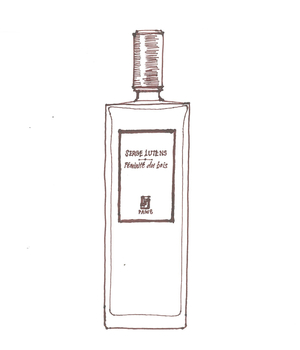 Féminité du Bois was launched in 1992 for Shiseido, the Japanese beauty company for which Serge Lutens created many striking ad campaigns, and which backed him in the launch, the same year, of his super-chic Salons du Palais Royal. It was in its original incarnation that I first encountered Féminité du Bois, and what first caught my eye was the design of the bottle – a lovely teardrop-shaped glass container, designed by Lutens himself.
Féminité du Bois was launched in 1992 for Shiseido, the Japanese beauty company for which Serge Lutens created many striking ad campaigns, and which backed him in the launch, the same year, of his super-chic Salons du Palais Royal. It was in its original incarnation that I first encountered Féminité du Bois, and what first caught my eye was the design of the bottle – a lovely teardrop-shaped glass container, designed by Lutens himself.
Sadly that style of bottle disappeared in 2009, when Lutens left Shiseido and set up in his own name; the perfume went with him, repackaged in his signature bottles – a tall, slim, rather flat rectangular design, stylish in its own right but not as poetic as Shiseido’s original.
Recommending a perfume called Féminité du Bois to men might sound like a rather capricious (not to say perverse) enterprise, but many great fragrances transcend the gender associations that their names, and their marketing, impose on them, and this is one of the most beautiful fragrances I know.
Floral scents may be thought of as quintessentially feminine, and it would take a very confident man to wear something that smelled predominantly, say, of jasmine or of rose. Yet some of the most popular men’s perfumes have flowers in them – violets in Grey Flannel, for example, or jasmine in Eau Sauvage.
Féminité du Bois is, if you like, a mirror image of these kinds of men’s fragrance: a nominally female fragrance made more, rather than less alluring by the addition of elements that are generally associated with the opposite sex. The master stroke, in this case, is the combination of sweet, rather girly smells – violets and plum (the fruit rather than the flower) – with the masculine, pencil-shaving smell of cedar wood.
It’s one of those combinations that works so well that you wonder why nobody had thought of it before, but I guess that’s the mark of genius – in this case the genius of British perfumer Christopher Sheldrake (who worked on many of the Serge Lutens fragrances before getting snapped up by Chanel) and the legendary Pierre Bourdon (Cool Water, Kouros and many others).
The first time I tried out Féminité du Bois my reaction was ‘This smells exactly like Bel Ami’. Which is to say, like pencil shavings, which is the main – and very appealing – impression you get from the classic Hermès scent. But moments later you realise that there’s more going on inside the woodiness, and the warmth and slight sweetness of plum, violets and spices blend with the cedar to make an effortlessly satisfying whole.
Luxury can mean different things to different people: for some, bling is the thing, but for others luxury means high quality and discretion – and that’s the kind of luxury Féminité du Bois suggests to me. It’s neither brash nor overpowering, which makes it eminently wearable, but nor is it faint or feeble. Try it for yourself and I hope you’ll see what I mean.
Hermès
Eau de Narcisse Bleu
10 October, 2014
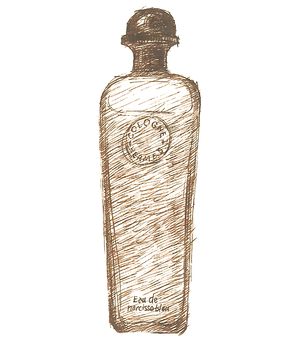 Pretty much everyone I know loves Hermès’ deliciously fresh and zingy Eau d’Orange Verte, so when Eau de Narcisse Bleu (literally ‘blue narcissus water’) was launched in 2013 it had a tough act to follow. As I’ve never seen a blue narcissus / daffodil, I think it’s safe to say that this perfume has an element of fantasy about it, and as a smell, too, it’s perhaps rather more complex and a little less instantly accessible than its predecessor. But give it a little time and I think it’ll grow on you.
Pretty much everyone I know loves Hermès’ deliciously fresh and zingy Eau d’Orange Verte, so when Eau de Narcisse Bleu (literally ‘blue narcissus water’) was launched in 2013 it had a tough act to follow. As I’ve never seen a blue narcissus / daffodil, I think it’s safe to say that this perfume has an element of fantasy about it, and as a smell, too, it’s perhaps rather more complex and a little less instantly accessible than its predecessor. But give it a little time and I think it’ll grow on you.
Eau de Narcisse Bleu may not have the euphoric mood-lifting freshness of Eau d’Orange Verte, but it has a gentle softness that, once you’ve smelled it for a while, is extremely appealing in its own right. It does have the faint sweetness of real daffodil flowers (try sticking your nose in one on a sunny day next March and you’ll see what I mean), but what narcissus extract smells of most, rather unexpectedly, is fresh hay. *
Now, I have nothing against smelling of hay, which is a lovely scent in its own right, but what Hermès’ much-mythologised perfumer, Jean-Claude Ellena, has done is blended the smell of hay with a whole raft of subtly complementary fragrances. Most of them are quite ‘green’ – that is, they smell fresh and natural, like grass and leaves, but not especially sweet or flower-like.
To me it has a slight but definite scent of fig-leaves, which for anyone who loves L’Artisan Parfumeur’s wonderful Premier Figuier as much as I do can only be a good thing. Whether this figginess is (excuse the pun) a figment of my imagination I’m not sure, but among the other ingredients that Ellena lists is galbanum, which is extracted from the root of a wild Iranian plant that looks a bit like fennel or cow-parsley, and indeed is distantly related to them.
Galbanum has a marvellously fresh sappy smell like newly-snapped pea-pods, and is one of the most important components of ‘green’ perfumes, but its greenness, here, is tempered by the hay-like sweetness of narcissus, with a hint of earthy bitterness underneath which manages to stop it from smelling at all girly.
If my description makes it sound a bit complicated, don’t be put off, for it’s such a well-blended perfume that there’s nothing discordant about it. In fact if anything it is, perhaps, a little too gentle for its own good, as it’s a ‘quiet’, thoughtful scent that stays close to your skin and doesn’t, on the whole, grab other people’s attention. It’s discreet and refined, in other words, rather than a ‘look-at-me’ perfume, which is perfect if you want to smell good without drawing attention to yourself. Go try it.
* I say ‘narcissus extract’, but one of the irritating things about perfume marketing is how vague – and frankly clueless – most descriptions of perfume ingredients actually are. For as anyone who actually grows the things themselves knows full well, a bright-yellow daffodil like Narcissus ‘February Gold’ smells very different to Narcissus papyraceus, the so-called paperwhite narcissus; the former has a gentle, hay-like scent, while one of the big selling-points of paperwhites is their powerful, almost jasmine-like perfume, the sweetness of which, en masse, can have a touch of the slightly repellent stagnant-water smell that perfumers refer to as ‘indolic’. If only perfume PRs were taught some basic botany.
Postscript – mystery solved, but only by going to the source: in France last week I visited IFF-LMR, the legendary natural raw perfume materials company near Grasse, and what should we get talking about but their narcissus extract, which is derived from the beautiful Narcissus poeticus, fields of which grow wild in the uplands of the Lozère. Did they use other species of daffodil as well? No, came the answer, and it’s their extract that you’re smelling (among many other things) in Eau de Narcisse Bleu.
Lalique
Hommage à l’homme
29 April, 2014
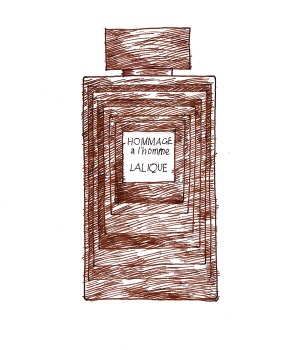 Now here’s a tough one. Hommage à l’homme was the first perfume I reviewed whose London launch I attended and whose creator I met, but it’s also the first perfume I reviewed that I didn’t actually enjoy.
Now here’s a tough one. Hommage à l’homme was the first perfume I reviewed whose London launch I attended and whose creator I met, but it’s also the first perfume I reviewed that I didn’t actually enjoy.
On the whole I dislike knocking things, and generally I’d rather not mention fragrances that do nothing for me, but given the number of new launches each year there are bound to be some duds, so if I’m going to recommend scents that appeal to me it seems only honest to come clean about the ones that don’t.
Lalique has a long association with perfume, going back to 1908, when the ground-breaking French perfumer François Coty commissioned René Lalique to design perfume labels for him. Soon Lalique was designing perfume bottles too, and over the decades the company became known for its innovative techniques and the superb quality of its workmanship.
It wasn’t until 1992, though, that Lalique launched a perfume of its own, the imaginatively named Lalique de Lalique. There are now 19 Lalique perfumes to choose from, and Hommage de l’homme is the fourth to be marketed for men.
Hommage de l’homme marks two decades of perfume production, so you’d hope it’d be something special. My problem is that – to me at least – it smells totally generic, and not in a good way. Yes, I can vaguely smell the violets and saffron that we’re told it contains, but they’re completely overpowered by the same toxic chemical smell that spoils so many otherwise promising men’s fragrances.
Ever since I first recoiled from my first sniff of Dior’s Higher in 2001, every other mainstream men’s fragrance seems to have been stuffed full of the same noxious ingredient, which gets right up my nose. It has a harsh, acrid odour, like you get when your computer blows up – a burnt-plastic smell that I wouldn’t want in a toilet cleaner, never mind a perfume I might spray on my skin.
I’ve been puzzling what this secret component could be, if only so I could avoid it – could it be some kind of natural or synthetic extract of black pepper? Would someone like to tell me? Whatever it is, for me it’s a trend that, like Ugg boots, has long outlasted its welcome. Please, perfumers, move on.
PS: Finally someone has identified it: the much-appreciated Grooming Guru, Lee Kynaston – now we know!
Etro
Greene Street
26 April, 2014
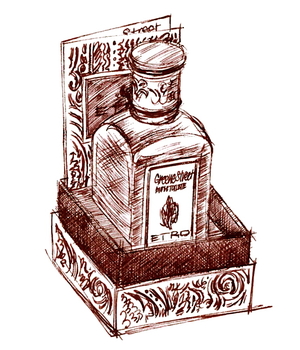 The Italian fashion brand Etro made its name with a neo-hippy mix of paisley prints and clashing colours, so it’s no surprise that, among the 25-odd perfumes they’ve released since 1989, there’s the occasional whiff of patchouli and joss-sticks.
The Italian fashion brand Etro made its name with a neo-hippy mix of paisley prints and clashing colours, so it’s no surprise that, among the 25-odd perfumes they’ve released since 1989, there’s the occasional whiff of patchouli and joss-sticks.
Their latest nod in that direction is Greene Street, launched in 2012 to coincide with the opening of their second Manhattan boutique on – you’ve guessed it – Greene Street in SoHo. According to Etro, ‘the western bohemian spirit is the heartbeat of the quarter’, though given that near neighbours include Chanel and Marc Jacobs, Etro’s idea of bohemian may be rather different from yours and mine.
As for the perfume, here’s what they say about it: ‘A symphony of spices create the perfect scent for the modern cosmopolitan man, for those who follow fashion but add their own unique touch of personality to every look. Versatile and distinctive, this perfume also magically adapts a more feminine tone when worn by a woman, thanks to the seductive subtle undertones.’
Got that? Personally I think it smells a bit like that old Body Shop hit from the 1980s, Dewberry, with its slightly choke-inducing mixture of spice and fruitiness. In Greene Street’s case, the scent ingredients include pepper (specifically the ‘pink pepper’ that, in the perfume world, has been so puzzlingly fashionable for the last few years), underpinned with nutmeg, violet and incense, among other things.
I’ve no idea which perfumer created Greene Street, though I see that a number of Etro’s previous fragrances were put together by the French perfume company Robertet; maybe one day we’ll be told, but there again they may be perfectly happy to remain anonymous.
It’s not a horrible perfume, which instantly sets it above most of its competitors on department-store shelves around the world, but neither can I see it becoming one of my favourites. Which is a shame, as much as anything because I think that Greene Street is particularly well packaged and presented.
I haven’t, up to now, included packaging when I’ve illustrated a perfume, but I like this box so much, with its abstract paisley design on the outside and purple inner lining, that I think it’s worth a mention – not least because storing perfumes in their boxes is so much better for them than exposing them to light, and really well-designed packaging is a great encouragement on that front. So two cheers for retro Etro.